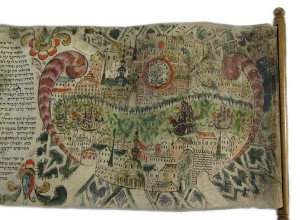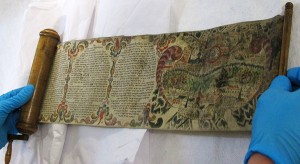Today, 16 March, Jewish communities are celebrating Purim. On this holiday, the biblical Book of Esther is read aloud in synagogue. In keeping with tradition, the story of Esther—who saves the Jewish people in the Persian Empire from destruction by Haman, the king’s highest-ranking official—is read not from a book but from a parchment scroll. Commenting on the (Hebrew) reading, noisy hoots and rattles are sounded. (Alternative customs are described in our blog text for last year’s Purim).
Numerous Esther scrolls are currently in the custody of the Jewish Museum. The 32 works on loan will be on display along with other historical manuscripts from 4 April 2014, in the special exhibition “The Creation of the World. Illustrated Manuscripts from the Braginsky Collection.” The oldest scrolls date back to the mid-seventeenth century and each megillah, as the scrolls are called in the Hebrew, is artfully illustrated. As befits the joyful event narrated in the Book of Esther, megillot (plural form) are often colorful and adorned with illustrations.
It delights us, the museum staff, to behold such magnificent objects. For this reason, the past weeks were particularly moving – and busy. Once the objects arrived from Zurich, the museum’s paper conservators unpacked them in the presence of the curators. While this is happening, everyone involved in the exhibition watches closely. The conservators compare the objects with the records supplied by the lender, then compile a report on their current condition. Since everything arrived safely, the scrolls now need only wait for the showcases to be finished.
The scrolls will go on display courtesy of René Braginsky, whose private collection of Jewish manuscripts has already been shown in part in Amsterdam, New York and Jerusalem. His collection encompasses many precious and rare artifacts of inestimable value – which is a joy to my scholar’s heart. The Jewish Museum Berlin is very fortunate to have the opportunity to exhibit such highlights. All visitors to the museum are cordially invited to admire these treasures of manuscript art from 4 April onwards.
Michaela Roßberg, Temporary Exhibitions

